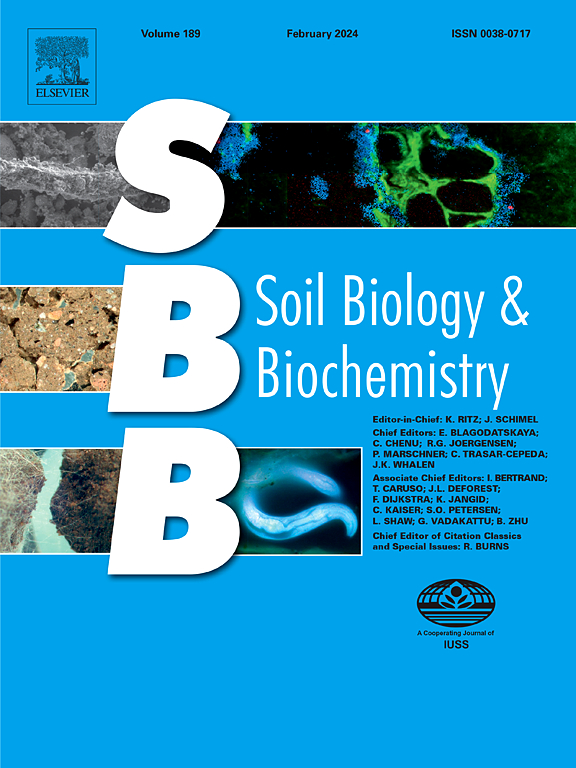再湿润以及添加生物炭和硫酸盐可以减轻温室气体排放,并在退化的高地泥炭地中保留碳
IF 9.8
1区 农林科学
Q1 SOIL SCIENCE
引用次数: 0
摘要
泥炭土在全球范围内储存了大量的碳(C),增加泥炭地的碳固存可在抵消人为温室气体(GHG)排放方面发挥作用。因此,有必要找到并评估最佳温室气体清除(GGR)干预措施,以最大限度地减少温室气体损失、保护现有碳储量并促进进一步固碳。这项中型宇宙研究评估了不同富含碳的基质(君子兰秸秆或君子兰衍生生物炭)和/或硫酸亚铁(FeSO4)添加剂在低地下水位(LW;-15 厘米)和高地下水位(HW;0 厘米)条件下,从退化的高地泥炭中提取的完整土柱(直径 20 厘米 x 深 25 厘米)的额外碳储存潜力。在一年时间内测量了温室气体通量、可溶性养分、微生物群落结构和酶活性的变化,以评估净碳储存量及其总体 GGR 潜力。与低地相比,高地的二氧化碳排放量减少了 28%,而甲烷排放量则增加了,最终占未添加任何添加剂的高地岩心的二氧化碳当量(CO2eq)温室气体总排放量的 61%。有机添加物对 CO2 和 CH4 排放量有显著影响,其中秸秆-HW 的累计排放量最高(26.2 吨 CO2eq ha-1 yr-1),生物炭+硫酸亚铁+HW 的累计排放量最低(7.9 吨 CO2eq ha-1 yr-1)。生物炭+FeSO4+HW产生的土壤碳净增量最大,抑制了原生泥炭-碳的分解和甲烷的排放。通过替代电子受体防止甲烷生成,FeSO4 的应用大大减少了 CO2eq 温室气体的排放。生物炭+高水位处理抑制了 22% 的子囊菌丰度。高水位、生物炭添加和替代电子受体(如 FeSO4)的可用性相结合,可通过非生物和生物机制增加净碳积累和 GGR,包括 i) 增加碳输入;ii) 调节土壤微生物群以减少泥炭周转;iii) 抑制 CH4 和 N2O 排放。本文章由计算机程序翻译,如有差异,请以英文原文为准。
Rewetting alongside biochar and sulphate addition mitigates greenhouse gas emissions and retain carbon in degraded upland peatlands
Peat soils store significant amounts of carbon (C) globally, and increased C sequestration into peatlands could play a role in offsetting anthropogenic greenhouse gas (GHG) emissions. As such, there is a need to find and assess optimal greenhouse gas removal (GGR) interventions to minimise GHG losses, protect current C stocks, and promote further C sequestration. This mesocosm study assessed the additional C storage potential of different C-rich substrates (Juncus straw or Juncus-derived biochar) and/or FeSO4 amendments, with a low water table (LW; −15 cm) and high-water table (HW; 0 cm) in intact soil columns (20 cm diam. x 25 cm deep) extracted from degraded upland peat. GHG fluxes, soluble nutrients, changes in microbial community structure and enzyme activity were measured over a one-year period to evaluate the net C storage and their overall GGR potential. HW reduced CO2 emissions by 28 % compared to LW, while CH4 emissions increased, ultimately contributing 61 % of the overall CO2 equivalent (CO2eq) GHG emissions in HW cores with no amendments. Organic amendments had a significant effect on CO2 and CH4 emissions with the highest cumulative emissions being from the Straw-HW (26.2 t CO2eq ha−1 yr−1) and the lowest cumulative emissions being from the Biochar + FeSO4+HW (7.9 t CO2eq ha−1 yr−1). Biochar + FeSO4+HW led to the strongest net gain in soil C, suppressing decomposition of the native peat-C as well as CH4 emissions. The application of FeSO4 significantly reduced CO2eq GHG emissions by preventing methanogenesis through alternative electron acceptors. The Biochar + HW treatment suppressed Ascomycota abundance by 22 %. The combination of a high-water level, biochar addition and availability of alternative electron acceptors (e.g., FeSO4) can increase net C accumulation and GGR via both abiotic and biotic mechanisms, including i) increased C input, ii) modulation of soil microbiome to reduce peat turnover; and iii) suppression of CH4 and N2O emissions.
求助全文
通过发布文献求助,成功后即可免费获取论文全文。
去求助
来源期刊

Soil Biology & Biochemistry
农林科学-土壤科学
CiteScore
16.90
自引率
9.30%
发文量
312
审稿时长
49 days
期刊介绍:
Soil Biology & Biochemistry publishes original research articles of international significance focusing on biological processes in soil and their applications to soil and environmental quality. Major topics include the ecology and biochemical processes of soil organisms, their effects on the environment, and interactions with plants. The journal also welcomes state-of-the-art reviews and discussions on contemporary research in soil biology and biochemistry.
 求助内容:
求助内容: 应助结果提醒方式:
应助结果提醒方式:


